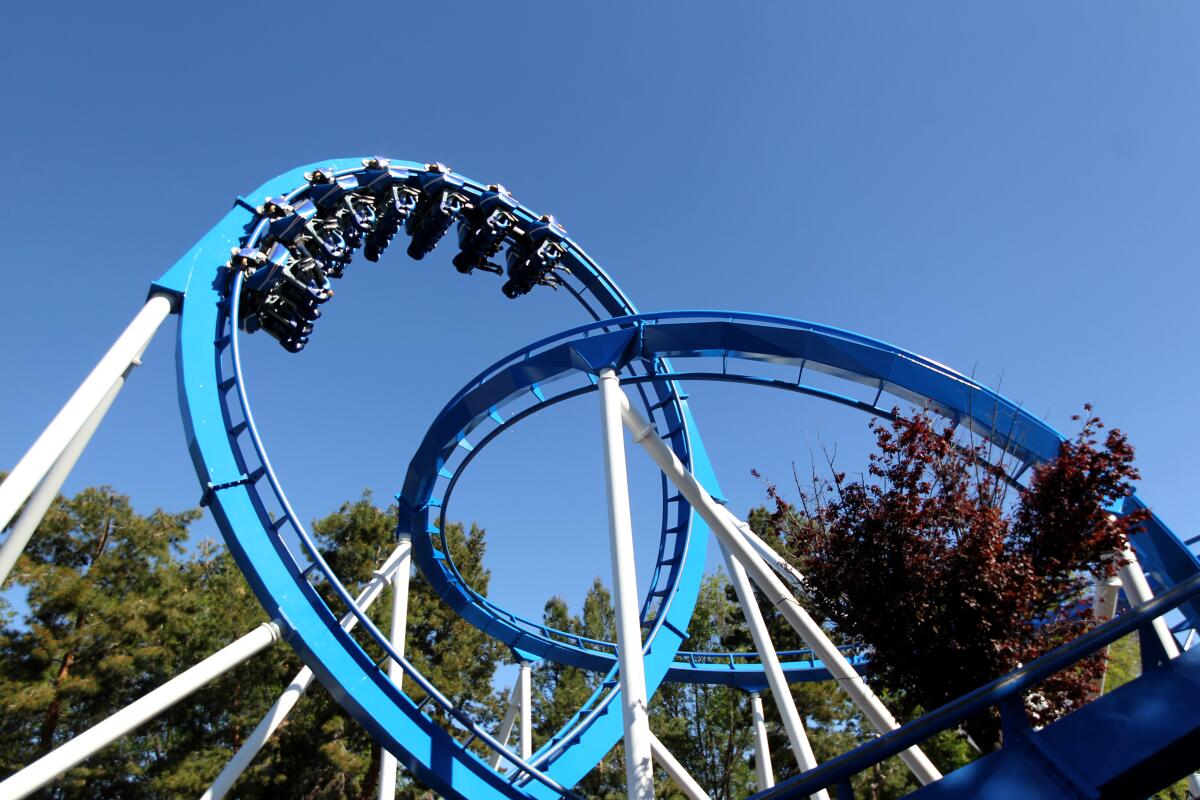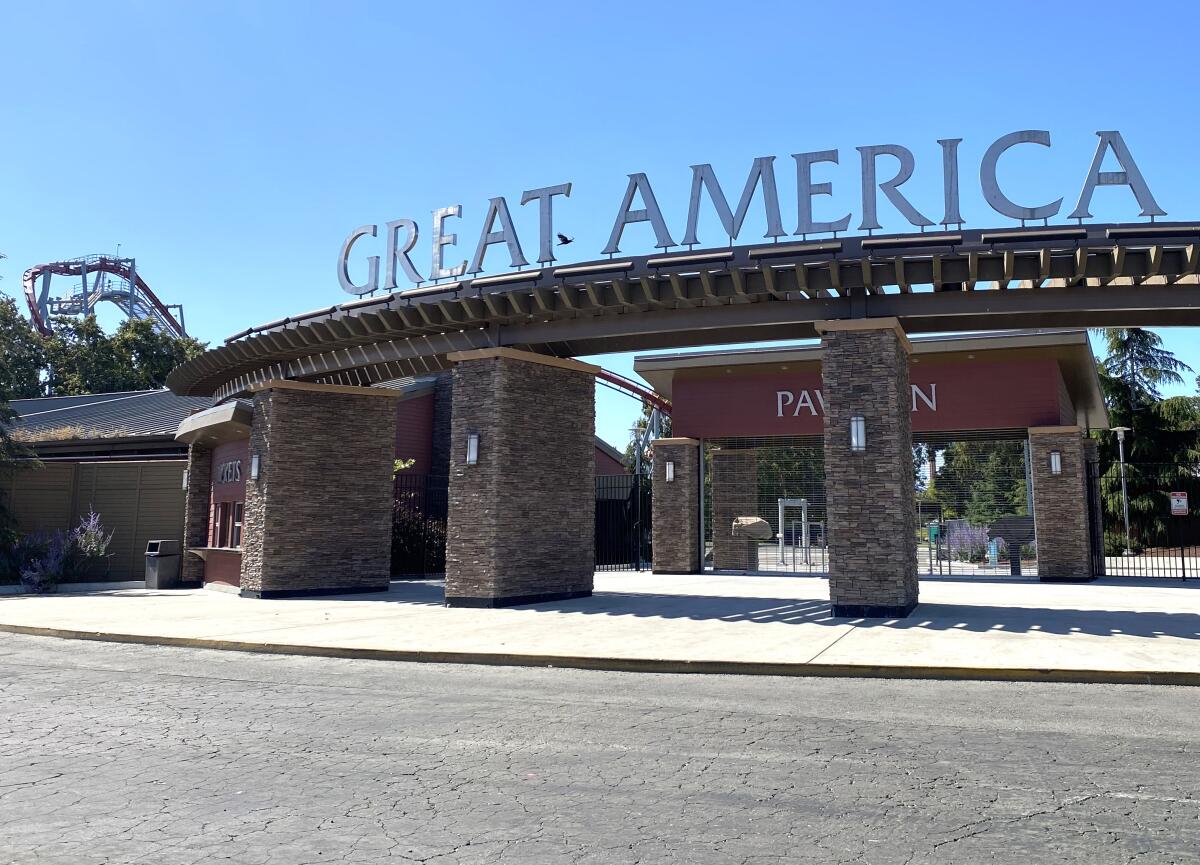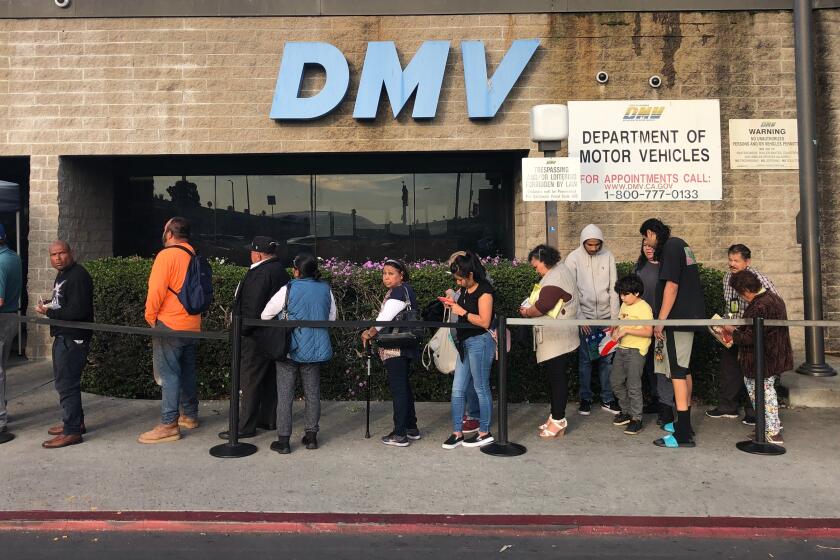Great America was the Bay Area’s Disneyland. Now it’s a victim of Silicon Valley’s tech boom

- Share via
SANTA CLARA, Calif. — When Great America amusement park in Santa Clara opened in 1976, it quickly became the Bay Area’s version of Disneyland.
It was never as popular or iconic as Walt Disney’s Anaheim landmark, but Great America quickly became the go-to theme park for families and tourists — and a welcome diversion in a quiet Silicon Valley suburbia that locals say is low on thrills.
But Great America is now poised to close in coming years as part of a huge real estate deal that speaks to the dramatically changing development patterns in California’s tech capital.
When Great America was built on the quiet edge of San Francisco Bay, the tech boom was in its early stages. Since then, giant developments and housing complexes, including the in-progress Google village in downtown San Jose, have popped up around it. Apple’s new headquarters is a few miles away in Cupertino, and Facebook is north in Menlo Park.
The Great America location is now considered prime because of quick access to mass transit lines. Although officials haven’t confirmed what the park’s 112 acres could be converted into, real estate experts speculate that because of the property’s immediacy to multiple rail lines, it could serve as a combination of commercial, industrial and residential space amid a housing shortage in the region.
It’s part of a larger real estate boom. With the Bay Area Rapid Transit network finally making its way into San Jose through the Silicon Valley Extension program, denser development is planned for the once-sleepy downtown area and other places along the route. In the next few years, BART, which ends in North San Jose, is expected to stretch into downtown and Santa Clara.
“With this site in particular, given its size and proximity to transit — there’s a light rail nearby and heavy rail — it’s one of the largest remaining underutilized sites in the region,” said Jeff Bellisario, executive director of the Bay Area Council Economic Institute. “We’re seeing a company seizing an opportunity over the long term and taking advantage of Silicon Valley’s positioning with its tech hub.”
The property’s adjacency to public transportation (there’s a Valley Transportation Authority station and an Altamont Corridor Express train station behind Levi’s Stadium next door) has the potential to draw employees from other regions who might not otherwise have taken jobs in the South Bay, Bellisario said. He also wouldn’t rule out residential buildings and could see the property become a mixed-use development site.
“We’re seeing people moving out of city areas and dense centers and moving toward job centers, so the ability to move people, it becomes more attractive as companies look at hiring patterns,” he said. “People may be willing to make a 60-minute train ride but not a 60-minute car ride.”
Silicon Valley continues to see high demand for new industrial properties, according to Silicon Valley Commercial Brokerage founder Mary Wadden.
“The industrial market in and of itself is extremely tight, so there’s a huge demand for that. It didn’t take a downturn during the pandemic at all — it even tightened,” she said.
Santa Clara County Assessor Lawrence Stone pointed to tech giants continuing to expand their reach in the South Bay — including Google’s downtown San Jose neighborhood and Apple’s recently leased Sunnyvale office campus — as indicators that companies aren’t shying away from real estate development during the pandemic.
“With Apple, Google and LinkedIn, all of these companies are buying or building, and last year was a record year in the history of high tech in Silicon Valley for acquisition and long-term leasing in industrial property,” Stone said. “Everyone talks about COVID recession, and it’s real, but Silicon Valley has special resilience to make changes in economic activity that isn’t the case in most other places.”
Stone doesn’t believe that parkgoers will “notice a single thing” for the better part of 11 years leading up to the park’s closure.
“It’s nothing like the closure of mall-based retailers like Toys R Us and Lord & Taylor — all of them closed in the last six to eight years,” he added. “I think that has a greater impact on the local Silicon Valley.”
Cedar Fair, the owner and operator of Great America, as well as 11 other parks, including Knott’s Berry Farm, sold the amusement park to real estate developer Prologis for $310 million in an effort to reduce its debt. Prologis is a major player in industrial, logistics and manufacturing development.
Under the terms of a rental agreement laid out with the Securities and Exchange Commission, Prologis has agreed to lease the land back to Cedar Fair for the next six years, with the option to renew the lease for five years. That means the park could close as soon as six years from now, and 11 years at the most.
“We chose Prologis as our partner because of their deep ties in the Bay Area and their reputation for working closely with local communities on large developments,” Richard Zimmerman, chief executive of Cedar Fair, said in a news release.
The park, located between Highway 101 and State Route 237 near Levi’s Stadium, opened in 1976 under Marriott Corp. and has become a local landmark for thrill-seeking Bay Area residents and families looking to spend a day in the sun. The park changed hands several times over the decades, including the city of Santa Clara and Paramount Communications, the owner of Paramount Pictures. Cedar Fair acquired the park in 2006 and bought the land from Santa Clara in 2019 after leasing the property for more than 40 years.
Although Great America’s shuttering could be a decade away, the inevitable closure marks the end of an era for lovers of the park.
San Francisco resident Jordan Del Rosario, 26, has been going to Great America since he was in sixth grade. He said it was “saddening” that the park will close.
“With the memories of Great America, I will cherish them until the very end,” he said. “I feel that the more tech buildings that they build in the South Bay, the less entertainment we have here in NorCal. I think it’s like a hit-or-miss, so we don’t know what the future holds.”
Del Rosario, who compared the park to Disneyland in terms of its significance to Northern California, took comfort in the fact that the Bay Area still has a Six Flags Discovery Kingdom. “I’ll go with friends and families if they’re interested,” he said.
Joe Azar-Williams, a San Francisco resident, was one of hundreds standing in line Wednesday waiting to get into the park for a private work event.

“The South Bay is short on things of entertainment value and unique things to do, so obviously closing the park is just one fewer thing in the South Bay to actually do,” he said. “I could understand if they were to build some high-density residential housing here — that may be a greater utility in the South Bay considering what the housing situation is like here.”
Azar-Williams moved to the Bay Area in 2020 and works as a software engineer.
“I lived in the South Bay and I moved because it was really boring, so it kind of speaks to that,” he added.
Nidhi Modh, a Livermore resident who was visiting the park with her daughter Wednesday morning, said she understands why Cedar Fair would want to sell the property during a land shortage in the Bay Area.
“I have mixed feelings,” she said. “Given what’s happening economy-wise and how many companies have come out and there’s a shortage of land ... I can understand why they’d want to close. It’s unfortunate for families to not be able to come here, but at the end of the day, these are business decisions.”
More to Read
Sign up for Essential California
The most important California stories and recommendations in your inbox every morning.
You may occasionally receive promotional content from the Los Angeles Times.











